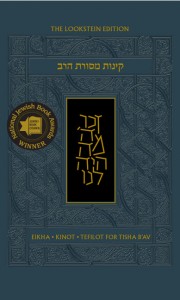Excerpted from the Koren Mesorat HaRav Kinot: Lookstein Edition. Edited by Rabbi Simon Posner, Kinot translated by Rabbi Dr. Tzvi Hersh Weinreb.
Kina 22
The Rav discusses what we mourn for on Tisha B’Av. It is not only the Hurban Beit HaMikdash in the material sense, but also the Hurban Beit HaMikdash in the spiritual sense, the destruction of centers of Torah and the thousands of towns and villages over the ages where Jews lived a sacred life.
After shifting from kinot for the Hurban Beit HaMikdash to a kina for the Ten Martyrs, there is now a further shift in the subject matter of the kinot. This kina (Hacharishu Mimeni Va’adabera) is the first of several commemorating the massacres in Speyer, Mainz and Worms, and other related tragedies during the Crusades in Germany at the end of the eleventh century. These kinot recount the Hurban Batei Mikdash of the Hakhmei Ashkenaz, the slaughter of the Torah scholars and the destruction of the Jewish communities.
In a sense, however, this kina is a continuation of the kina “ארזי הלבנון.” In both kinot, the deaths that are described represent a double catastrophe. Thousands of Jews were killed during the Crusades. But the tragedy was not just the murder of ten people during the Roman times or the myriads during the Crusades. The tragedy was also the fact that the greatest scholars of the Jewish people were killed. In this kina, the mourning that is expressed is not just for the inhuman act of the massacre. Rather, the principal emphasis is on the destruction of the Torah centers in Germany.
The dates of these massacres are known to us. The Crusaders generally started out on their journey in the spring, and the massacres took place in the months of Iyar and Sivan, around the time of Shavuot. Even though these events did not occur on Tisha B’Av, they are included in the kinot and are commemorated on Tisha B’Av because of the principle, already noted in connection with other kinot, that the death of the righteous is equivalent to the burning of the Beit HaMikdash. If the Beit HaMikdash was sacred, how much more sacred were entire Jewish communities which consisted of thousands of scholars. These communities were also, collectively, a Beit HaMikdash in the spiritual sense. If the kinot speak about the Hurban Beit HaMikdash in the material sense, they also mourn the Hurban Beit HaMikdash in the spiritual sense, the destruction of centers of Torah and the killing of great Torah scholars.
In fact, sometimes the death of the righteous is even a greater catastrophe than the destruction of the physical Beit HaMikdash.
There is an additional reason for including these kinot dealing with the massacres in Germany in the Tisha B’Av service. Hurban Beit HaMikdash is an all-inclusive concept. All disasters, tragedies and sufferings that befell the Jewish people should be mentioned on Tisha B’Av. Rashi says (II Chronicles 35:25, s.v. vayitnum lehok) that when one has to mourn for an event, it should be done on Tisha B’Av. When these kinot relating to the Crusades are recited, one should remember that the tragedies being described happened not only in 1096 but in the 1940s as well. These kinot are not only a eulogy for those murdered in Mainz, Speyer and Worms, but also for those murdered in Warsaw and Vilna and in the hundreds and thousands of towns and villages where Jews lived a sacred and committed life. The kinot are a eulogy not only for the Ten Martyrs and those killed in the Crusades, but for the martyrdom of millions of Jews throughout Jewish history.


